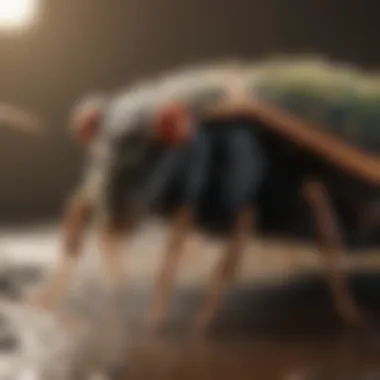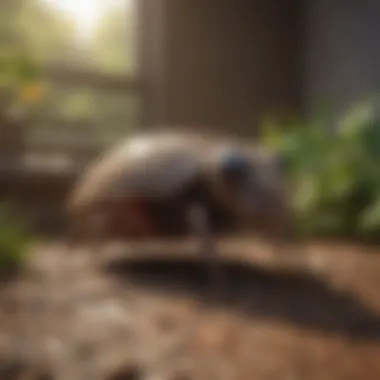Comprehensive Insights into Planet Pest Solutions


Intro
Pest management remains a vital aspect of maintaining both health and property integrity in various settings. As the world grapples with increasing ecological challenges, understanding these organisms becomes essential. Planet Pest Solutions stands at the forefront, advocating for diverse methodologies in effective pest control. This article navigates pest identification, prevention techniques, and sustainable practices—all crucial for homeowners and gardening enthusiasts. With advancements in technology and the pressing need for ecological awareness, informed pest management takes center stage.
Understanding Pests
Definition of Pests
Pests are organisms detrimental to human interests, whether through damage to crops, spreading illness, or affecting quality of life. The range of pests is broad, encompassing insects like termites and mosquitoes, rodents such as rats and mice, and even weeds that compete with cultivated plants. Understanding their behavior and biology is important for crafting effective management strategies.
Importance of Pest Identification
Effective pest management begins with accurate identification. Misidentifying a pest can lead to ineffective treatments, wasting resources and potentially worsening the problem. Homeowners should learn common pest species relevant to their environment. Resources like Wikipedia or Britannica provide useful information for understanding local pest populations, enabling targeted strategies.
Prevention Techniques
Home and Garden Preventative Measures
Preventive strategies are crucial for minimizing pests. Key measures include:
- Regular inspections of your home and garden to identify potential pest entry points.
- Proper waste disposal, ensuring that trash is secured to prevent attracting pests.
- Sealing cracks and crevices in building foundations to block pest access.
In gardens, using companion planting can help deter pests naturally. Herbs like basil or marigold can repel common garden intruders while enhancing plant health.
Seasonal Prevention Tips
Different seasons bring varying pest challenges. Adapting prevention techniques can make a significant difference. Consider the following tips:
- Spring: Monitor for emerging pests and take early action.
- Summer: Focus on lawn maintenance to prevent infestations.
- Fall: Clear debris and seal entrances as pests look for winter shelter.
- Winter: Check for signs of pests seeking warmth indoors.
Eco-Friendly Pest Control Solutions
Overview of Sustainable Practices
Sustainability in pest management prioritizes practices that minimize harm to the environment. Integrated Pest Management (IPM) forms a comprehensive approach, combining biological, cultural, and mechanical controls before resorting to chemical options. This method fosters a balanced ecosystem where beneficial insects thrive alongside managed pest populations.
Natural Remedies and Their Effectiveness
Natural remedies have gained popularity as effective alternatives to chemical treatments. Methods such as diatomaceous earth, neem oil, and essential oils can deter pests without harming beneficial species. These options are preferable for environmentally conscious homeowners. However, effectiveness can vary, requiring some experimentation to find the most suitable solutions for specific pest problems.
"Informed pest management practices not only protect property but also contribute to ecological preservation."
Understanding Pest Management
Pest management is a critical discipline that safeguards our homes, gardens, and health from the adverse effects of pests. In this context, it is essential to recognize the significance of understanding pest management both in everyday life and in broader ecological terms. Proper pest management not only maintains the aesthetic and functional aspects of our living spaces but also protects our health and wellbeing.
Key factors to consider include the impact of various pests on human life, the effectiveness of different management methods, and the need for balanced approaches that consider environmental sustainability. By developing a comprehensive understanding of pest management, homeowners can make informed choices that significantly mitigate pest-related issues. This awareness leads to reducing reliance on harmful chemicals, thus cultivating healthier living environments.
Definition and Importance
Pest management refers to the activities and methodologies used to control or eliminate unwanted organisms that pose threats to public health, agriculture, and property. The importance of effective pest management lies in its potential to enhance quality of life and protect both ecological systems and human health.
- Public Health: Pests, such as rodents and insects, can transmit diseases to humans. Managing these pests is crucial to prevent outbreaks and safeguard communities.
- Agricultural Productivity: Pests can harm crops, leading to reduced yields. Managing pests ensures food security and boosts economic stability for farmers.
- Property Protection: Termites and similar pests can cause significant damage to structures, leading to costly repairs. Effective pest management helps preserve property value.
The Pest Management Lifecycle
The pest management lifecycle involves various stages that help in understanding how pest control efforts can be optimized.
- Identification: In the initial phase, it is crucial to recognize the types of pests present. Different pests require unique control strategies, and proper identification is vital.
- Assessment: Evaluate the level of infestation and the potential risks involved. This phase determines the urgency and type of management strategy needed.
- Implementation: Based on the assessment, appropriate control measures are executed. This may include mechanical, biological, or chemical methods tailored to the specific pest situation.
- Monitoring and Evaluation: After implementation, it is important to monitor the effectiveness of the chosen methods. Continuous assessment helps in adapting strategies and improving future pest management efforts.


Understanding this lifecycle assists homeowners in making informed and strategic decisions. By following these steps, they can achieve long-term pest control and contribute to a healthier ecosystem.
Integrated Pest Management (IPM) Strategies
Integrated Pest Management (IPM) strategies play a crucial role in modern pest control methods. This comprehensive approach combines various practices to manage pest populations effectively while minimizing risks to human health and the environment. The significance of IPM lies in its ability to address both immediate pest issues and long-term sustainability. By integrating multiple strategies, homeowners can reduce dependency on chemical products and foster a healthier living space.
Principles of IPM
The principles of IPM are essential to its successful implementation. IPM is built on a foundation of understanding pest biology, ecology, and the specific environment where they're situated. Some key principles include:
- Identification: Accurate identification of pests is vital. Knowing the specific pest allows for targeted solutions, reducing unnecessary treatments.
- Monitoring: Regular monitoring of pest populations helps determine when intervention is necessary. This also helps track trends in pest presence over time.
- Thresholds: An economic threshold is determined for pests; this is the point at which the cost of pest damage exceeds the cost of control measures. This principle helps in making informed decisions about intervention timing.
- Diverse Methods: IPM employs diverse control methods, combining biological, cultural, physical, and chemical approaches for a balanced control scheme.
The amalgamation of these principles fosters a more environmentally sustainable method. It encourages the use of natural pest control agents and methods to keep pest populations at manageable levels.
Monitoring and Assessment Techniques
Effective monitoring is the backbone of any IPM strategy. This involves regular observation and data collection to assess pest presence and damage levels. Several techniques can be applied:
- Visual Inspections: Regularly check plants and indoor areas for signs of pests. Look out for unusual damages or pest droppings.
- Sticky Traps: These are effective for monitoring flying insect populations. Place them strategically to catch pests and determine their presence and abundance.
- Soil Sampling: For soil-dwelling pests, sampling can reveal the types and numbers present, aiding in decision-making regarding control.
Regular assessments of pest populations help determine if and when control measures should be implemented. By adapting monitoring techniques, homeowners can stay ahead of potential infestations.
Focus on Prevention
Prevention is a critical aspect of IPM and often the most effective strategy in long-term pest control. Preventive measures minimize the likelihood of pest issues arising in the first place. Here are some important preventive strategies:
- Sanitation: Keeping homes and gardens clean discourages pests. Regularly dispose of waste, and ensure proper storage of food and garden supplies.
- Physical Barriers: Use screens, barriers, and traps to exclude pests from entering living spaces. This is particularly effective for insects.
- Plant Selection: Choosing disease-resistant and pest-repelling plant species can significantly reduce the chance of infestations in gardens.
"Prevention not only saves effort but also enhances the overall health and aesthetics of your home environment."
By prioritizing prevention, homeowners achieve a proactive stance in pest management, reducing the reliance on reactive treatments.
Common Pests: Identification and Impact
Understanding common pests is essential for effective pest management as pests can disrupt daily life and have significant impacts on health and property. Recognizing these pests not only aids in prompt detection but also allows for the implementation of appropriate control measures. Additionally, identifying pests helps homeowners differentiate between harmful species and beneficial insects.
Recognizing Common Household Pests
Household pests vary widely in their appearance and behavior. Some of the most common include:
- Rodents: Mice and rats are frequent invaders. They can chew through wiring and cause structural damage.
- Ants: Different species like the odorous house ant can contaminate food. They often form large colonies that can be difficult to control.
- Cockroaches: Known for their resilience, cockroaches can spread diseases. Their presence often indicates unsanitary conditions.
- Bed Bugs: These pests feed on human blood at night, causing itchy welts. They can be challenging to eliminate once infested.
Identification typically involves observing the pest's physical characteristics, nesting habits, and behaviors. Homeowners can use online resources or consult with pest control experts for accurate identification.
The Ecological Role of Insects
Insects play a crucial role in ecosystems. While some are pests, many contribute positively to their environment. They are essential for:
- Pollination: Bees and butterflies, for example, pollinate plants, aiding in food production.
- Decomposition: Beetles and termites break down organic matter, recycling nutrients.
- Food Source: Many birds and mammals rely on insects as a primary food source, linking them to the food chain.
An appreciation of beneficial insects encourages environmentally friendly pest management practices, focusing on the preservation of useful species while controlling harmful ones.
Economic and Health Implications
Pests can result in significant economic losses and health concerns. Homeowners may face:
- Property Damage: Termites alone cause billions in damage annually, necessitating costly repairs.
- Health Risks: Rodents and cockroaches can transmit diseases such as hantavirus and salmonella, respectively. Allergies and asthma can also be triggered by pest droppings.
The financial burden extends beyond immediate damages; ongoing costs stem from pest control services and preventative measures. Investing in proper identification is crucial as it leads to targeted solutions, reducing overall pest management expenses.


Proper pest identification ensures timely intervention, preventing economic losses and protecting health.
Eco-Friendly Pest Control Practices
Eco-friendly pest control practices are essential in modern pest management. As awareness of environmental issues grows, many homeowners are seeking ways to manage pests that do not harm the ecosystem. These practices focus on harmony between human needs and nature, offering sustainable solutions while effectively controlling pest populations.
Biological Control Agents
Biological control agents refer to natural predators or parasites that can effectively keep pest numbers in check. For example, ladybugs are beneficial insects that consume aphids. By introducing these beneficial species to the garden, homeowners can create a balanced ecosystem that reduces the need for chemical pesticides.
A key benefit of biological agents is their long-lasting effects. Once established, these agents can continue to provide pest control without ongoing effort. Introducing biological control is also safe for humans and pets, minimizing harmful exposures to toxic substances. It is crucial, however, to select appropriate agents that are native to the area. Non-native species might disrupt local ecosystems and cultivate new problems instead of solving them.
Cultural Control Techniques
Cultural control techniques involve altering the environment to make it less hospitable to pests. This can include crop rotation, adjusting irrigation methods, and proper sanitation practices. By eliminating standing water, homeowners can significantly reduce mosquito populations. Likewise, ensuring plants are healthy and well-spaced reduces disease spread.
Such practices are simple to implement and often cost-effective. They not only manage pests but also enhance the overall health of the ecosystem. Adopting cultural practices means investing in long-term solutions rather than short-lived results. Households that engage in cultural control will likely find a noticeable decrease in pest populations over time.
Natural Repellents and Deterrents
Natural repellents are substances derived from plants or other natural resources that deter pests. For instance, peppermint oil can repel ants and spiders, while diatomaceous earth serves to restrict the movement of a variety of insects. Implementing these deterrents can reduce reliance on synthetic pesticides and lower exposure risks.
The use of natural repellents also aligns well with organic gardening practices. Homeowners can easily make homemade repellents with simple ingredients found in the kitchen. This approach not only provides pest control but also promotes greater awareness of the substances used in the home environment.
"Choosing eco-friendly pest control practices is a step towards a healthier home and a more sustainable planet."
By focusing on biological control agents, cultural techniques, and natural repellents, homeowners can effectively manage pests while preserving the health of the environment. These practices not only protect property but also contribute to a larger commitment to sustainable living. As trends shift towards eco-friendliness, adopting such methods becomes increasingly relevant for any conscientious homeowner.
Chemical Pest Control Solutions
Chemical pest control solutions play a significant role in the comprehensive framework of pest management. While sustainable practices have gained traction, chemical methods remain a vital tool for many property owners. Understanding these solutions is essential, as they can provide immediate results when pest issues arise. However, it is imperative to balance their use with safety and environmental considerations.
Overview of Pesticide Use
Pesticides are chemical substances designed to eliminate or control pests. They can be categorized into various types based on their target pest or their chemical composition. Historically, pesticides have been utilized in agricultural and residential settings to protect crops and property from invasive species. When applied correctly, they offer effective solutions to severe infestations. However, misuse or over-reliance can lead to adverse environmental effects and health risks.
Homeowners should engage in educated practices regarding pesticide use. The goal is to achieve effective pest control without harming beneficial insects or the surrounding ecosystem. Moreover, understanding the labels and guidelines on products is crucial for safe application and to minimize unnecessary exposure.
Types of Pesticides
Pesticides can be broadly classified into several categories. Each type serves a specific purpose depending on the kind of pest and the context of use. The major types include:
- Insecticides: Target insects such as ants, cockroaches, and termites.
- Herbicides: Control unwanted plants or weeds.
- Fungicides: Address fungal infections impacting plants.
- Rodenticides: Specifically designed to eliminate rodents like mice and rats.
Understanding the type of pesticide is essential for effective pest management. Not all products work the same way and choosing the right one can enhance effectiveness and reduce risks.
Safety and Regulation
Safety is a crucial aspect when dealing with chemical pest control solutions. Regulatory bodies impose strict guidelines to ensure that pesticides can be used safely. In many regions, the Environmental Protection Agency (EPA) is responsible for evaluating and approving pesticide products before they hit the market.
Homeowners should familiarize themselves with these regulations. Proper storage, application techniques, and disposal methods are essential to mitigate risks. Misapplication not only endangers health but can also disrupt local ecosystems.
It is advisable to follow all instructions. For example, using personal protective equipment (PPE) while handling chemicals can prevent potential exposure during application. Awareness and adherence to these safety regulations ultimately contribute to a more responsible approach to pest management.
"Chemical solutions should be seen as part of a larger pest management strategy, emphasizing collaboration with other methods for a balanced approach."
Technological Advances in Pest Management
Technological advancements play a crucial role in modern pest management. With the increasing understanding of ecosystems and pest behavior, technology offers innovative solutions that enhance efficiency, accuracy, and safety. These advancements not only improve the effectiveness of controlling pest populations but also ensure minimal harm to surrounding wildlife and plants. By integrating technology into pest management practices, households and pest control professionals can respond proactively to infestations and environmental challenges.


Emerging Technologies
Several emerging technologies are transforming the pest management landscape. These include, but are not limited to, automated monitoring systems, drones, and smart traps. Automated monitoring systems utilize sensors that detect pest activity and environmental conditions, sending real-time data to pest control specialists. This allows for immediate intervention and reduction of pesticide use.
Drones, equipped with high-resolution cameras and sensors, facilitate large scale surveys of properties, quickly identifying pest infestations even in hard-to-reach areas. They provide data that was previously time-consuming to gather, improving decision-making processes in pest management strategies.
Smart traps, which often employ digital alerts, replace traditional traps, making it easier for homeowners to manage pest issues. These devices not only capture pests but also notify users when they are engaged.
Utilizing Data and AI in Pest Control
Data analytics and artificial intelligence (AI) are further reshaping pest management. By aggregating vast amounts of data from multiple sources, AI algorithms can predict pest behaviors based on temperature, humidity, and historical infestation patterns. This predictive capability enables more targeted and effective pest control measures.
For example, AI can determine the optimal timing for pesticide application, thereby increasing effectiveness and reducing unnecessary treatments. Pest control companies can analyze past data to adjust their strategies and offer tailored solutions to clients. AI models can even assist in developing pest-resistant crops, providing long-term solutions that align with sustainable practices.
The Future of Pest Solutions
Looking forward, the combination of advanced technologies and sustainable practices shapes the future of pest management. Innovations such as gene editing and microbial pest control are on the horizon. Gene editing could assist in creating pest-resistant species, reducing reliance on chemical solutions.
Furthermore, there is a potential for enhanced biopesticides that are more effective and environmentally friendly. These new methods promise to be not only effective but also practical, pushing the boundaries of traditional pest control. Future solutions will emphasize integrated approaches, ensuring that environmental factors are always considered in management strategies.
"The infusion of technology into pest management is not just a trend; it is a necessary evolution aimed at preserving biodiversity while managing pest risks effectively."
Legal and Ethical Considerations
Legal and ethical considerations play a crucial role in pest management. These aspects ensure that pest control methods are not only effective but also responsible and sustainable. Homeowners and pest control professionals must understand the relevant laws and ethical guidelines that govern their actions. By complying with regulations, they not only protect their property but also safeguard the environment and public health.
Regulations Governing Pest Control
Regulations governing pest control vary by country and region. In many places, specific laws dictate the types of chemicals that can be used, their application methods, and safety measures that must be followed. For instance, the Environmental Protection Agency (EPA) in the United States plays a significant role in regulating pesticide use. They evaluate the safety of pesticides and ensure that only products meeting strict criteria can be marketed to consumers.
Homeowners and pest control companies must also comply with local laws. This may include obtaining permits for certain pest management practices. Understanding these regulations helps avoid legal disputes and ensures the safety of humans, animals, and the environment. It is beneficial for homeowners to educate themselves about these laws to make informed decisions about pest control options.
Ethics of Extermination
The ethics of extermination involve moral principles guiding how pests are managed. Not all pests pose the same level of threat to humans, and exterminating non-harmful species can disrupt local ecosystems. Ethical pest management emphasizes the need for humane approaches when dealing with pests. This includes avoiding unnecessary harm to non-target species and considering alternatives to lethal methods.
For example, when faced with rodent infestations, more humane options like traps can be considered before resorting to poison or extermination. Homeowners should evaluate the implications of their pest control choices.
"Choosing responsible pest management reflects a commitment to ecological balance and community health."
Community involvement and awareness are essential in promoting ethical pest management. Engaging with local experts and community programs can educate homeowners on the best practices for pest control. In this way, they can contribute to a more ethical approach that considers the broader impact of their actions.
By prioritizing regulations and ethical considerations, homeowners can practice pest management that is not only effective but also respects the environment and promotes public health.
Future Directions in Pest Management
The arena of pest management is undergoing a significant transformation. As environmental concerns rise and pest populations become more resistant to traditional extermination methods, the future direction of pest management must incorporate innovative systems and sustainable practices. This section highlights key aspects of future pest solutions, exploring the benefits and considerations that shape this critical field.
Sustainable Practices
Sustainable practices in pest management prioritize ecological balance. By reducing dependency on chemical solutions, they protect both human health and environmental integrity. Integrated Pest Management (IPM), for instance, embodies a sustainable paradigm. The emphasis is on prevention, habitat manipulation, and biological control, allowing nature to contribute to pest regulation. Some sustainable techniques include:
- Crop Rotation: Changing the type of crops grown in an area can disrupt the life cycles of pests, preventing infestations.
- Natural Predators: Utilizing beneficial insects, like ladybugs or lacewings, can naturally reduce pest populations.
- Companion Planting: Certain plants repel pests or attract beneficial insects, creating a natural balance in gardens.
Incorporating these methods not only enhances ecosystem health but also offers long-term solutions. Homeowners can participate in sustainable practices by implementing native plants and maintaining biodiversity in their gardens. The growing trend towards organics correlates with health-conscious consumer choices, directing further research and development into eco-friendly pest solutions.
Community Involvement and Awareness
Community involvement significantly enhances pest management efforts. By educating neighborhoods about pest control strategies, communities can collectively address pest issues at a larger scale. Awareness initiatives aim to inform residents about:
- Pest Identification: Understanding which pests are common helps in identifying threats early.
- Cooperative Strategies: Neighbors can collaborate to share tools, resources, and knowledge in maintaining pest-free environments.
- Impact of Pollution: Highlighting how indiscriminate use of chemicals can harm local ecosystems encourages responsibility.
"Empowering communities through knowledge and collaboration can lead to the effective management of pests while preserving our shared environment."
Community workshops, local extension services, and online forums can serve as platforms for information dissemination. Social media can enhance outreach, creating networks of support among residents facing similar challenges. Through shared goals and resources, communities become resilient, equipped to tackle pest-related issues effectively.
As we move forward, incorporating sustainable practices coupled with active community involvement creates holistic pest management strategies. Together, households and neighborhoods can play a critical role in shaping a future that honors ecological principles while effectively managing pest populations.



